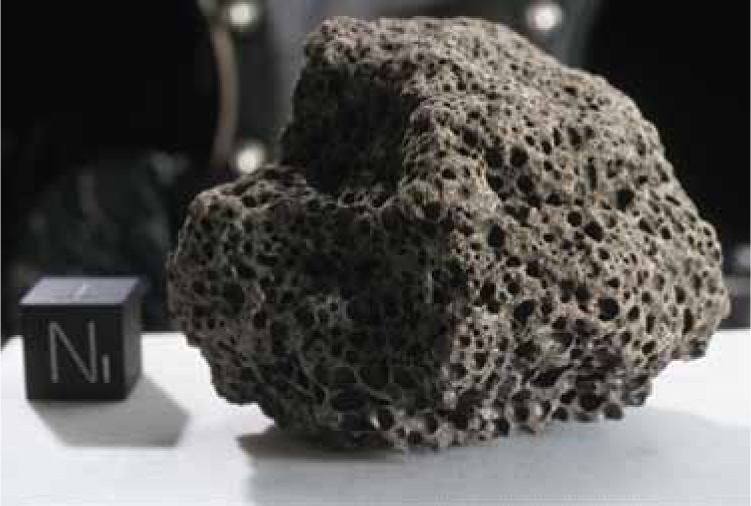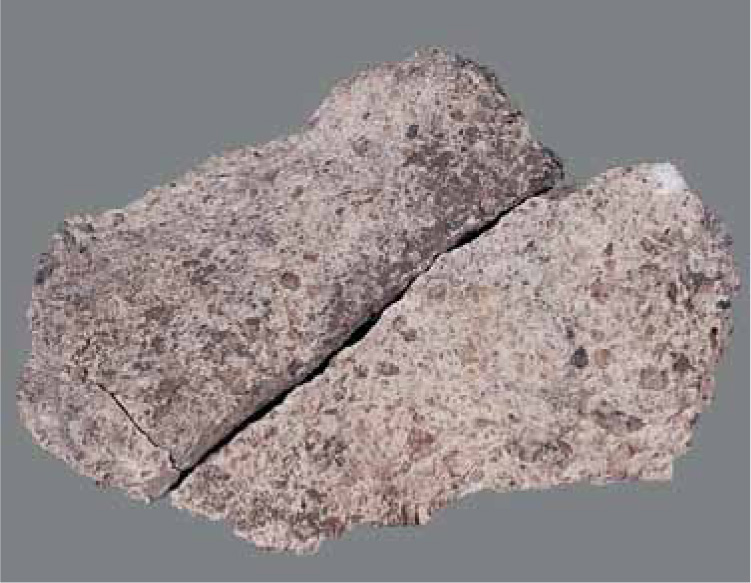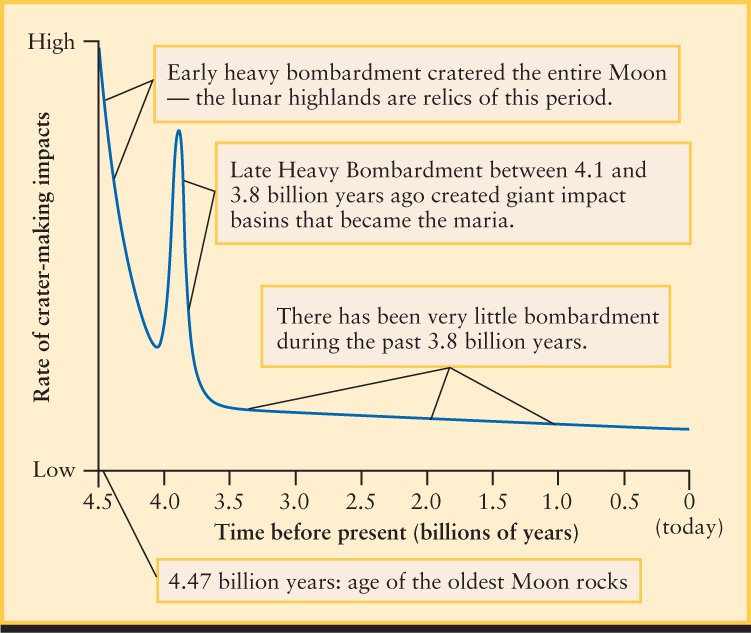10-4 Lunar rocks reveal a geologic history quite unlike that of Earth
One of the most important scientific goals of the Apollo missions was to learn as much as possible about the lunar surface. Although only one of the 12 astronauts who visited the Moon was a professional geologist, all of the astronauts received intensive training in field geology, and they were in constant communication with planetary scientists on Earth as they explored the lunar surface.
Weathering by Micrometeorites and the Solar Wind
Although no wind or rain disturbs the lunar surface, it is “weathered” over the ages by the impact of tiny meteoroids
The Moon has no atmosphere or oceans to cause “weathering” of the surface. But the Apollo astronauts found that the lunar surface has undergone a kind of erosion due to billions of years of relentless micrometeorite bombardment. When lunar astronauts retrieved equipment left on the moon two years earlier, micrometeorite impacts showed that this weathering is still taking place. Another significant form of weathering comes from bombardment by charged particles in the solar wind.

The Regolith Billions of years of bombardment by space debris have pulverized the uppermost layer of the Moon’s surface into powdered rock. This layer, called the regolith, is utterly bone dry. It nonetheless sticks together like wet sand, as shown by the sharp outline of an astronaut’s bootprint.
On longer timescales, craters fewer than 400 meters wide could be erased by weathering over a period of hundreds of millions of years to perhaps a billion years (this is used to date the scarps shown in Figure 10-8). This bombardment has pulverized the surface rocks into a layer of fine powder and rock fragments called the regolith, from the Greek for “blanket of stone” (Figure 10-15). This layer varies in depth from about 2 to 20 m. Just as porous foam material helps to absorb sound waves in a recording studio, the regolith absorbs most of the light waves, or sunlight, that falls on it. This absorption of light helps to explain why the Moon only reflects about 11% of incident sunlight (see albedo, Table 10-1), compared to a typical Earth desert that reflects about 25% of incident light.
Research reported in 2012 suggests that the regolith might be dangerous for lunar explorers. As the Apollo astronauts found, even after wearing sealed space suits when venturing about, fine regolith dust eventually makes its way into living quarters. The dust is sharp like glass, and some of the particles are very small. Small particles are particularly dangerous for the lungs, where they can lodge deep into lung tissue and cause a range of serious health problems.
While the effects of weathering can be dangerous to the touch, the impacts that cause weathering might provide an intriguing visual display. Meteorites smaller than 1 mm in size are referred to as micrometeorites, but less frequent impacts by larger objects still occur. These larger impacts might solve a mystery that is more than 500 years old—a sparkling moon. Observers have long noted occasional flashes of light from the moon, although their origin and even their very existence, was in dispute. In 2012, researches found that when meteorites as small as 10 cm hit the lunar surface, enough heat is generated to produce light that is visible from Earth. Such events—called transient lunar phenomena—can occur hundreds of times a year, and are more frequent during meteor showers.
Moon Rocks

Mare Basalt This 1.53-kg (3.38-lb) specimen of mare basalt was brought back by the crew of Apollo 15. Gas must have dissolved under pressure in the lava from which this rock solidified. When the lava reached the airless lunar surface, the pressure on the lava dropped and the gas formed bubbles. Some of the bubbles were frozen in place as the rock cooled, forming the holes on its surface. (Figure 9-18a shows a sample of basalt from Earth.)
In addition to their observations of six different landing sites, the Apollo astronauts brought back 2415 individual samples of lunar material totaling 382 kg (842 lb). In addition, the unmanned Soviet spacecraft Luna 16, 20, and 24 returned 300 g (⅔ lb) from three other sites on the Moon. This collection of lunar material has provided important information about the early history of the Moon that could have been obtained in no other way.
All of the lunar samples are igneous rocks; there are no metamorphic or sedimentary rocks (see Section 9-3, especially Figure 9-18). The presence of only igneous rocks suggests that most or all of the Moon’s surface was once molten. Indeed, Moon rocks are composed mostly of the same minerals that are found in volcanic rocks on Earth.
Astronauts who visited the maria discovered that these dark regions of the Moon are covered with basaltic rock quite similar to the dark-colored rocks formed by lava from volcanoes on Hawaii and Iceland. The rock of these low-lying lunar plains is called mare basalt (Figure 10-16).
In contrast to the dark maria, the lunar highlands are composed of a light-colored rock called anorthosite (Figure 10-17). On Earth, anorthositic rock is found only in such very old mountain ranges as the Adirondacks in the eastern United States. Anorthosite is less dense than basalt. As a result, during the period when the Moon’s surface was molten, the less dense anorthosite rose to the top, forming the majority of the present-day lunar surface.

Impact Breccias These rocks are evidence of the Moon’s long history of bombardment from space. Parts of the Moon’s original crust were shattered and strewn across the surface by meteoritic impacts. Later impacts compressed and heated this debris, welding it into the type of rock shown here. Such impact breccias are rare on Earth but abundant on the Moon.

Anorthosite The light-colored lunar terrae (highlands) are composed of this ancient type of rock, which is thought to be the material of the original lunar crust. Lunar anorthosites vary in color from dark gray to white; this sample from the Apollo 16 mission is a medium gray. It measures 18 × 16 × 7 cm.
Although anorthosite is the dominant rock type in the lunar highlands, most of the rock samples collected there were not pure anorthosite but rather impact breccias. These rocks are composites of different rock types that were broken apart, mixed, and fused together by a series of meteoritic impacts (Figure 10-18). The prevalence of breccias is evidence that the lunar highlands have undergone eons of bombardment from space.
By carefully measuring the abundances of trace amounts of radioactive elements in lunar samples and applying the principles of radioactive dating (see Section 8-2), geologists have determined that lunar rocks formed more than 3 billion years ago. Of these ancient rocks, however, anorthosite is much older than the mare basalts. Typical anorthositic specimens from the highlands are between 4.0 and 4.3 billion years old. All of these extremely ancient specimens are probably samples of the Moon’s original crust. In sharp contrast, all the mare basalts are between 3.1 and 3.8 billion years old. With no plate tectonics to bring fresh material to the surface, no new anorthosites or basalts have formed on the Moon for more than 3 billion years.
The History of Lunar Cratering

By correlating the ages of Moon rocks with the density of craters at the sites where the rocks were collected, geologists have found that the rate of impacts on the Moon has changed over the ages. The ancient, heavily cratered lunar highlands are evidence of an intense bombardment that dominated the Moon’s early history. For around half a billion years, rocky debris left over from the formation of the planets rained down upon the Moon’s young surface. As Figure 10-19 shows, this barrage extended from 4 billion years ago, when the Moon’s surface solidified, until about 3.8 billion years ago. At its peak, this bombardment from space would have produced a new crater of about 1 km radius somewhere on the Moon about once per century. (If 100 years seems like a long time interval, remember that we are talking about a bombardment that lasted hundreds of millions of years and produced millions of craters over that time.)
The rate of impacts should have tapered off as meteoroids, asteroids, and the even larger planetesimals were swept up by the newly formed planets. In fact, radioactive dating indicates that the impact rate spiked upward between 4.1 and 3.8 billion years ago (see Figure 10-19), and this period is referred to as the Late Heavy Bombardment. This spike in impacts is thought to have occurred throughout the inner solar system as the Jovian planets scattered planetesimals—before the solar system settled into its present configuration (see Section 8-6).
Whatever the explanation for the epoch of heavy bombardment, major impacts during this period gouged out the mare basins, which later filled with lava to form the maria (see the Cosmic Connections figure). The relative absence of craters in the maria (see Figure 10-5) tells us that the impact rate has been quite low since the lava solidified. During these past 3.8 billion years, the Moon’s surface has changed very little.
CONCEPT CHECK 10-4
Astronauts have left footprints on the Moon. With no wind or rain, do you expect that these features will last on the surface for a billion years?
No. Impacting micrometeorites constantly “weather” the surface of the Moon. After a billion years, this weathering might even erase a 400-meter-wide crater.